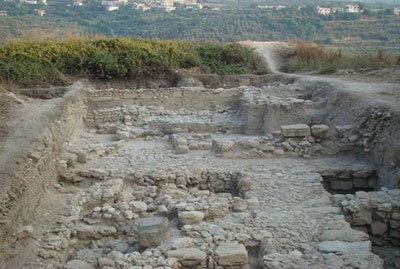LATTAKIA, (ST) – The Mediterranean region is distinguished by its ancient history and civilization where the oldest cities in the world still exist on the Syrian coast. Among these cities is Chou ski (Osokass) which represents a historical value and a combination of several civilizations of several cultures.
Archaeological discoveries confirm that this city, contemporary to Ugarit civilization, was a prosperous civilization during the second millennium BC. The city exposed to destruction, like many cities, at the hands of the invaders of the sea people that caused devastation and destruction to the civilizations of the Syrian coast in 1180 BC.
The city stands on a triangular -shaped hill located next to the sea port and 6 km south of the city of Jableh. It has two bays in the north and south. It oversees a plain, which is one of the largest and richest plains of the Syrian coast. It is surrounded by the mountains of the coast that pass along the beach at Lattakia and Banias, and it is 24 meters above sea level. The higher part of the location is ruins of an ancient city and the lower part is formed of calcareous rocks.
Ugaritic sources pointed out that Osokass hill is the Old City of Chou ski which seems to have been inhabited since thousands of years BC.
About the history of exploration and ages that have passed on the hill says researcher Dr. Jamal Haider director of the effects of Lattakia, said
“The Danish mission excavated between 1958 and 1963 and was able to monitor the successive civilizations in this site and probed between 1900 and 1750 BC. In the levels of this era accumulated skeletons, broken pottery, a small block of stone for making small votive statues similar to statues discovered in the Temple of al Massallat in Jbeil were found in the site,” Director of Lattakia Antiquities , Dr. Jamal Haider said.
The Late Bronze Age between 1600 and 1200 BC dates that the site was contemporary of Ugarit and indicated by the pottery and seals bearing scenes, similar to those found in Cyprus and Palestine. This level also gave more of Cypriot painted bowls, pots, statues, Phoenician cylindrical seals.
Landmarks of the hill belonging to the Iron Age embodied in houses and warehouses for agricultural products indicated by the presence of charred olive seeds and a lot of Greek pottery that confirmed the eating and drinking utensils were imported from Greece or manufactured in Phoenicia by Greek hands.
“Devastated walls of houses dating back to 168 BC Hellenistic era when Antonius the fourth invaded the whole Phoenician coast,” Dr. Haider said.
Signs of the Crusader era were discovered including remains of a demolished tower that was built by the Crusaders after the restoration of the area in 1192 AD. Landmarks of the Islamic era also were found including pottery discoveries, lamps, jug and coins dating back to the fourth century AD.
“The site of Osokass is a combination of a high level civilized mixture for several cultures, the most important of Canaanite, Phoenician and Arab-Islamic. Its port was distributing the domestic and imported goods to the Mediterranean region. Through its long history, the site formed a point of contact, cultural and trade communication across the Mediterranean between the cities of the Eastern Mediterranean and the west,” Dr. Haider concluded.
Sharif el -Khatib

